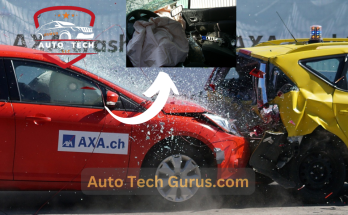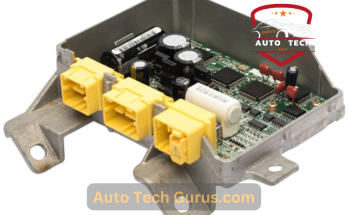The deployment of the airbag in your car is shocking. It will always leave the driver with so many unanswered questions, especially
concerning the next moves he takes. The common question is whether it’s possible and safe to start and drive the car after such an
incident. This guide gives clear, concise answers to your burning questions, so you can make the decision with much-needed confidence
after deploying an airbag.
How to Start a Car After Airbags Deploy: Step-by-Step
Starting a car after airbags deploy demands careful attention to both personal safety and the vehicle’s condition. Let’s dive into a comprehensive guide that ensures you cover all necessary safety checks and vehicle inspections seamlessly.
1. Begin by checking for injuries. Always prioritize your health and safety and that of any passengers. It is necessary to prioritize seeking medical attention for any injuries before focusing on the vehicle. Therefore, if you or anyone else involved in an accident gets injured, seek immediate medical attention first and then shift your attention toward the car.
2. Next, turn off the engine. If it’s still running after the airbags have deployed, shutting it off prevents further damage and reduces the risk of fire.
3. Then, shift to park or neutral. This step depends on your transmission type: set automatic transmissions to “Park” and manual transmissions to Neutral, engaging the parking brake for added security.
4. Make sure to turn off the ignition and remove the keys. This precaution prevents the car from accidentally starting during inspection, potentially leading to further damage or injury.
5. Safely exit the vehicle, but only if it’s safe to do so. This step helps you avoid additional hazards from oncoming traffic or the car itself.
Take a moment to assess the damage externally. Look for any fluid leaks, structural damage, or other hazards that might have resulted from the collision.
6. Check the electrical system next. Airbag deployment might automatically disconnect the battery as a safety measure, so inspect the battery and electrical connections thoroughly.
7. Some vehicles require the airbag system to be reset after deployment before they can start again. This process often involves the use of a reset button or switch located in the fuse box, under the dashboard, or in the engine compartment. Consult your vehicle’s manual for specific instructions.
8. Remember to inspect the safety systems. Ensure that seat belts, airbags, and other safety features are functional despite the impact.
Reconnect any disconnected components. The force of airbag deployment can sometimes disconnect electrical connections and sensors. Reconnect these components carefully to avoid further issues.
9. Inspect the battery for any indications of damage, such as cracks, leaks, or loose connections. Ensure it’s connected adequately before attempting to start the car.
10. Now, try to start the vehicle. If it doesn’t start after all safety checks are completed, avoid repeated attempts and instead seek professional assistance.
11. If the car starts, conduct a test drive at low speed in a safe area. Pay close attention to any unusual noises, handling issues, or dashboard warning lights that may indicate unresolved problems.
12. Check the airbag and dashboard warning lights. The airbag light will likely be illuminated after deployment. Address this and any other warning lights with a professional.
Finally, seek a professional inspection. Have a qualified mechanic or dealership inspect the vehicle for hidden damage to ensure it’s safe to drive. This step emphasizes the importance of professional advice and service, especially for critical safety features like airbags.
By following these steps, you address both immediate safety concerns and the vehicle’s long-term operability after airbag deployment. Remember, a thorough professional inspection is crucial for ensuring all necessary repairs are made, particularly to the vehicle’s safety features.
Starting a Nissan Vehicle After Airbag Deployment
Starting the vehicle after deploying an airbag will involve a few critical processes for Nissan owners. First, ensure that a car is safe and examine all obvious damages that may impede driving. And if the vehicle seems workable, start it in a typical way. If it doesn’t start, it probably indicates Nissan’s safety protocol sometimes, whereby the car fails to start as a measure of avoidance. In such a case, a professional must be called to diagnose the problem accurately.
Repairing a Car After Airbag Deployment
Repairing a car after airbags have been deployed is possible. Still, it depends on the extent of the damage and the car’s overall condition. Expert technicians should perform specialized tasks like airbag replacement and system resets. In some cases, the cost of repairs might exceed the car’s value, rendering it a total loss.
Starting a BMW After Airbags Have Deployed
For BMW drivers, the process is similar to that for Nissan. Ensure the vehicle is safe to operate, and attempt to start the engine. BMWs have sophisticated safety systems, so if the car doesn’t start, it’s likely a built-in safety measure. Professional diagnostics will be necessary to reset the system and address any damages.
In-Depth Look at Starting Specific Car Models After Airbag Deployment
The process of starting the car after airbag deployment can vary depending on the specific car model. For instance, luxury cars like BMW might have more complex safety systems than others. It’s essential to refer to the vehicle’s manual or consult with the dealership for model-specific instructions.
The Role of Vehicle Safety Systems in Post-Accident Scenarios
Modern vehicles are equipped with advanced safety systems that deploy airbags and take other actions during a collision. These may include cutting off the fuel supply, disconnecting the battery, or activating hazard lights. Understanding these systems can provide insights into why a car may not start immediately after an accident and what steps should be taken to restart the vehicle safely.
Professional Inspection and Repairs: Why They Matter
After airbag deployment, a professional inspection is crucial. This inspection should assess the vehicle’s structural integrity, electrical systems, and any other components that might have been affected. Professional repairs ensure that all safety systems are restored to their optimal condition, which is vital for the safety of the vehicle’s occupants.
Airbag System Reset: A Necessary Step
In many cases, after airbags have been deployed, the car’s airbag system will need to be reset. This process often requires professional tools and knowledge. A reset ensures the airbag system is ready to function again in case of another incident.
The Cost Factor in Airbag Deployment and Vehicle Repair
Repairing a car after an airbag deployment can be costly. The expenses include replacing the airbags, repairing any associated damage, and labor costs. In some cases, the cost of repairs can exceed the car’s value, leading to a total loss declaration by insurance companies. Getting a detailed estimate and weighing the options before proceeding with repairs are essential.
Buying a Car with Deployed Airbags: Additional Considerations
If you’re considering buying a car with its airbags deployed, conducting a thorough inspection is crucial. Ensure that all repairs have been carried out professionally. It’s also advisable to get a history report on the car to understand the extent of the damage and repairs.
Remember, a vehicle in a severe accident may have underlying issues that aren’t immediately apparent.
Legal and Insurance Implications
After airbag deployment, it’s also essential to consider the legal and insurance implications. In many regions, a car in a significant accident must pass a safety inspection before it’s legally allowed back on the road. Additionally, the accident may affect your car insurance premiums and coverage.
Safety First: The Bottom Line
The most crucial aspect to consider after an airbag deployment is safety. While cutting out deployed airbags or attempting DIY repairs, is technically possible, these actions compromise the vehicle’s safety. Always prioritize professional advice and services to ensure your car is safe.
Conclusion:
Navigating the aftermath of airbag deployment involves understanding legal, safety, and technical aspects. Always prioritize safety and
legal compliance, and seek professional assistance for inspections and repairs. Remember, each situation is unique, and what applies to
one car model might differ from another. Understanding what to do after airbags deploy in your car is crucial for your safety and the
legality of your vehicle. Whether it’s a Nissan, BMW, or any other model, the key is prioritizing safety, adhering to legal requirements,
and seeking professional assistance. By doing so, you can confidently navigate the post-accident scenario and ensure that your vehicle
remains a safe mode of transportation.
FAQ’s
Is It Legal to Drive a Car After Airbags Deploy?
First and foremost, let’s address legality. The legality of driving a car after airbag deployment varies based on local regulations and the extent of the damage. Generally, if the car’s safety features are compromised, it’s deemed unsafe and illegal. It’s crucial to consult with local authorities or a professional mechanic to understand your specific situation.
Why Won’t My Car Start After Airbags Deployed?
A car might not start post-airbag deployment for several reasons. Modern vehicles have an automatic shutdown feature that activates during significant impacts to prevent further damage. Additionally, electrical systems, including the battery, might be affected during the collision. It’s advisable to have a mechanic inspect the vehicle to determine the exact cause.
Can I Cut Out Deployed Airbags?
While you might be tempted to cut out deployed airbags, it’s not recommended. Airbags are crucial safety components, and their removal can compromise the vehicle’s safety integrity. Moreover, handling airbag systems requires specific expertise due to their sensitive nature. Always seek professional help for airbag issues.
Is a Car Considered Salvage If Airbags Deploy?
A car is typically labeled salvaged when the cost of repairs exceeds a certain percentage of its value, which varies by region. Airbag deployment alone doesn’t automatically classify a vehicle as salvage. Still, it’s a factor in assessing the overall damage and repair costs.
Should I Buy a Car If the Airbags Have Been Deployed?
Purchasing a car with previously deployed airbags is a good decision but requires due diligence. Ensure the airbags have been adequately replaced and the car has been thoroughly inspected and repaired by certified professionals. Review the vehicle’s history report for a detailed account of the incident and repairs.




